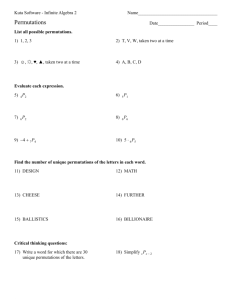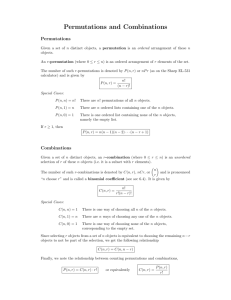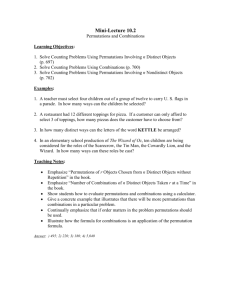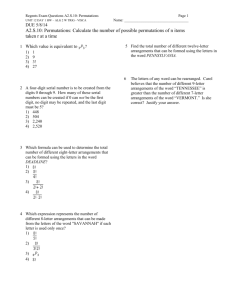Permutations and words - University of St Andrews
advertisement
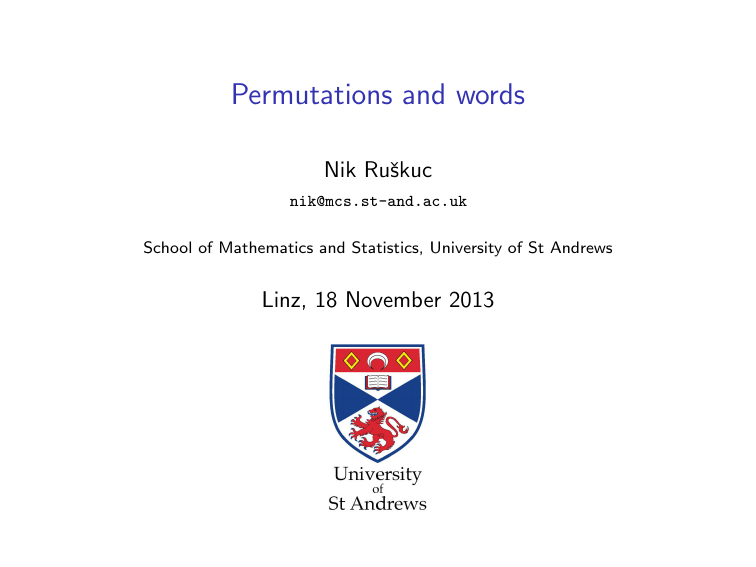
Permutations and words
Nik Ruškuc
nik@mcs.st-and.ac.uk
School of Mathematics and Statistics, University of St Andrews
Linz, 18 November 2013
Involvement of permutations
231 ≤ 631524
231 54132
≤
An infinite poset S.
Well founded: no infinite descending chains.
University of St Andrews
Nik Ruškuc: Permutations and words
Involvement of permutations
231 ≤ 631524
231 54132
≤
An infinite poset S.
Well founded: no infinite descending chains.
University of St Andrews
Nik Ruškuc: Permutations and words
Involvement of permutations
231 ≤ 631524
231 54132
≤
An infinite poset S.
Well founded: no infinite descending chains.
University of St Andrews
Nik Ruškuc: Permutations and words
Involvement of permutations
231 ≤ 631524
231 54132
3
≤
2
1
1
2
3
An infinite poset S.
Well founded: no infinite descending chains.
University of St Andrews
Nik Ruškuc: Permutations and words
Involvement of permutations
231 ≤ 631524
231 54132
≤
An infinite poset S.
Well founded: no infinite descending chains.
University of St Andrews
Nik Ruškuc: Permutations and words
Involvement of permutations
231 ≤ 631524
231 54132
≤
An infinite poset S.
Well founded: no infinite descending chains.
University of St Andrews
Nik Ruškuc: Permutations and words
Involvement of permutations
231 ≤ 631524
231 54132
≤
An infinite poset S.
Well founded: no infinite descending chains.
University of St Andrews
Nik Ruškuc: Permutations and words
Poset S
12345
54321
1234 1243 1324 1342
123
132
4321
213
231
12
312
321
21
1
University of St Andrews
Nik Ruškuc: Permutations and words
Pattern classes
Pattern class of permutations C: a downward closed set (ideal)
under ≤; i.e. σ ≤ τ ∈ C ⇒ σ ∈ C.
Basis B = B(C): the minimal permutations not in C.
C = {σ : (∀β ∈ B)(β 6≤ σ)} = Av(B).
Bases = antichains in S.
Not partially well ordered = infinite antichains = infinitely based
pattern classes.
Context: sorting mechanisms (stacks, queues); mathematical
biology; combinatorics of relational structures.
University of St Andrews
Nik Ruškuc: Permutations and words
Theory of Pattern Classes
What can be asked of a pattern class C?
◮
◮
Enumeration: cn = |Cn | = the number of permutations of
length n in C.
P
n
Generating function ∞
n=1 cn x : rational, algebraic,
holonomic?
◮
Asymptotic behaviour: estimate cn as n → ∞.
◮
Basis: finite, infinite, size?
◮
Order theoretic properties: antichains, pwo, join property,. . .
◮
Algorithmic problems: membership, complexity, computability
of the basis,. . .
◮
Model theoretic properties: simple permutations,
decompositions, structure, . . .
University of St Andrews
Nik Ruškuc: Permutations and words
Sample results
Theorem (folklore)
For any C = Av(π), |π| = 3, we have
1
2n
|Cn | =
.
n+1 n
Theorem (Regev 1981; Gessel 1990)
If C = Av(12 . . . r ) then
|Cn | ∼ (r − 1)n .
Theorem (Bona 1997)
The generating function for C = Av(1342) is
32x
.
2
−x + 20x + 1 − (1 − 8x)3/2
University of St Andrews
Nik Ruškuc: Permutations and words
Wilf–Stanley Conjecture (= Markus–Tardos Theorem)
Theorem (Markus, Tardos 2004)
For every pattern class C =
6 S there exists q ∈ R such that
n
|Cn | ≤ q .
Conjecture
p
n
|Cn | has a limit as n → ∞.
University of St Andrews
Nik Ruškuc: Permutations and words
Permutations and words
Do permutations, subject to pattern avoidance restrictions, behave
like words in some sense?
University of St Andrews
Nik Ruškuc: Permutations and words
Words
A – an alphabet; A∗ – words over A.
Subword ordering: abac ≤ cacbabca, abac 6≤ bacbca.
[Word = sequence; subword = subsequence.]
Downward closed set: u ≤ v ∈ X ⇒ u ∈ X .
University of St Andrews
Nik Ruškuc: Permutations and words
Words
A – an alphabet; A∗ – words over A.
Subword ordering: abac ≤ cacbabca, abac 6≤ bacbca.
[Word = sequence; subword = subsequence.]
Downward closed set: u ≤ v ∈ X ⇒ u ∈ X .
University of St Andrews
Nik Ruškuc: Permutations and words
Words
A – an alphabet; A∗ – words over A.
Subword ordering: abac ≤ cacbabca, abac 6≤ bacbca.
[Word = sequence; subword = subsequence.]
Downward closed set: u ≤ v ∈ X ⇒ u ∈ X .
University of St Andrews
Nik Ruškuc: Permutations and words
Poset W
aaa
aab
aba
aa
abb
baa
ab
bab
bba
ba
a
bbb
bb
b
ǫ
University of St Andrews
Nik Ruškuc: Permutations and words
Higman’s Theorem
Theorem (Higman 1952)
A∗ is PWO under ≤ (no infinite antichains).
Corollary
Every downward closed set has a finite basis.
Corollary
Every downward closed set W can be expressed as
∗
W =A \
n
[
A∗ ai ,1 A∗ ai ,2 A∗ . . . A∗ ai ,li A∗ .
i =1
Corollary
Every downward closed set is regular.
University of St Andrews
Nik Ruškuc: Permutations and words
Regular languages
Theorem (Kleene)
A language is regular iff it is accepted by a finite state automaton.
a
p
q
a
b
b
r
b
a
a
b
s
pn = qn−1 + rn−1
qn = pn−1 + sn−1
rn = pn−1 + sn−1
sn = rn−1 + qn−1
Corollary
Every regular set has a rational generating function, which can be
effectively computed.
University of St Andrews
Nik Ruškuc: Permutations and words
Back to permutations
Can we encode permutations by words, while preserving the nice
properties of the subword ordering?
University of St Andrews
Nik Ruškuc: Permutations and words
Rank encoding
Albert, Atkinson, NR 2003.
Replace every entry by the number of smaller entries after it +1.
Example: π = 2451637, ρ(π) = 2331211.
In general: need an infinite alphabet. But for some classes finite
alphabet suffices.
Ωk = {σ ∈ S : ρ(σ) ∈ [k]∗ } – a pattern class!
Example
C = Av({321, 312}). For every entry there is at most one smaller
entry to the right of it; C = Ω2 .
Example
Permutations generated by a system with finite memory (a graph).
University of St Andrews
Nik Ruškuc: Permutations and words
Rank encoding
Albert, Atkinson, NR 2003.
Replace every entry by the number of smaller entries after it +1.
Example: π = 2451637, ρ(π) = 2331211.
In general: need an infinite alphabet. But for some classes finite
alphabet suffices.
Ωk = {σ ∈ S : ρ(σ) ∈ [k]∗ } – a pattern class!
Example
C = Av({321, 312}). For every entry there is at most one smaller
entry to the right of it; C = Ω2 .
Example
Permutations generated by a system with finite memory (a graph).
University of St Andrews
Nik Ruškuc: Permutations and words
Rank encoding
Albert, Atkinson, NR 2003.
Replace every entry by the number of smaller entries after it +1.
Example: π = 2451637, ρ(π) = 2331211.
In general: need an infinite alphabet. But for some classes finite
alphabet suffices.
Ωk = {σ ∈ S : ρ(σ) ∈ [k]∗ } – a pattern class!
Example
C = Av({321, 312}). For every entry there is at most one smaller
entry to the right of it; C = Ω2 .
Example
Permutations generated by a system with finite memory (a graph).
University of St Andrews
Nik Ruškuc: Permutations and words
Rank encoding
Albert, Atkinson, NR 2003.
Replace every entry by the number of smaller entries after it +1.
Example: π = 2451637, ρ(π) = 2331211.
In general: need an infinite alphabet. But for some classes finite
alphabet suffices.
Ωk = {σ ∈ S : ρ(σ) ∈ [k]∗ } – a pattern class!
Example
C = Av({321, 312}). For every entry there is at most one smaller
entry to the right of it; C = Ω2 .
Example
Permutations generated by a system with finite memory (a graph).
University of St Andrews
Nik Ruškuc: Permutations and words
Rank encoding
Albert, Atkinson, NR 2003.
Replace every entry by the number of smaller entries after it +1.
Example: π = 2451637, ρ(π) = 2331211.
In general: need an infinite alphabet. But for some classes finite
alphabet suffices.
Ωk = {σ ∈ S : ρ(σ) ∈ [k]∗ } – a pattern class!
Example
C = Av({321, 312}). For every entry there is at most one smaller
entry to the right of it; C = Ω2 .
Example
Permutations generated by a system with finite memory (a graph).
University of St Andrews
Nik Ruškuc: Permutations and words
Involvement and rank encoding
Difficulty: Subpermutations don’t correspond to subwords.
ρ(2451637) = 2331211, ρ(234156) = 222111.
Hence: Pattern classes not encoded by downward closed sets of
words.
Fortunately, limited damage:
Proposition
The set
{(ρ(σ), ρ(τ )) : σ, τ ∈ Ωk , σ ≤ τ }
is recognised by a transducer (finite state translator).
University of St Andrews
Nik Ruškuc: Permutations and words
Rank encoding : results
Theorem
Let C ⊆ Ωk , and let B be its basis. Then ρ(C) is regular iff ρ(B) is
regular. In particular all finitely based subclasses of Ωk are regular.
Corollary
If C is a finitely based (or indeed regular) subclass of Ωk then:
(i) the generating function of C is rational;
(ii) it can be effectively computed from the basis of C;
(iii) the membership problem in C is decidable in linear time.
Follow-on development: Insertion encoding; Albert, Linton, NR,
2005.
University of St Andrews
Nik Ruškuc: Permutations and words
Gridding a permutation
3, 5, 4, 6, 9, 2, 11, 12, 1, 10, 8, 7
University of St Andrews
Nik Ruškuc: Permutations and words
Gridding a permutation
3, 5, 4, 6, 9, 2, 11, 12, 1, 10, 8, 7
University of St Andrews
Nik Ruškuc: Permutations and words
Gridding a permutation
3, 5, 4, 6, 9, 2, 11, 12, 1, 10, 8, 7
M=
University of St Andrews
0
1 −1
1 −1
0
Nik Ruškuc: Permutations and words
Geometric grid classes
Albert, Atkinson, Bouvel, NR, Vatter, to appear.
1 −1
1 −1
University of St Andrews
Nik Ruškuc: Permutations and words
Geometric grid classes
Albert, Atkinson, Bouvel, NR, Vatter, to appear.
University of St Andrews
Nik Ruškuc: Permutations and words
Geometric grid classes
Albert, Atkinson, Bouvel, NR, Vatter, to appear.
University of St Andrews
Nik Ruškuc: Permutations and words
Geometric grid classes
Albert, Atkinson, Bouvel, NR, Vatter, to appear.
University of St Andrews
Nik Ruškuc: Permutations and words
Geometric grid classes
Albert, Atkinson, Bouvel, NR, Vatter, to appear.
1352764
University of St Andrews
Nik Ruškuc: Permutations and words
Geometric grid classes: examples
Example
(1 1) defines the class of juxtapositions of two increasing
permutations.
Example (Atkinson 1999)
Av(321, 2143) is the union of geometric grid classes of (1 1) and
(1 1)T .
Example (Murphy 2003)
Av(132, 4312) is the geometric grid class of
0
0
1
1
0
0
Av(132, 4312) =
0
1
0
0 −1
0
0
0 −1
University of St Andrews
.
Nik Ruškuc: Permutations and words
Natural encoding
University of St Andrews
Nik Ruškuc: Permutations and words
Natural encoding: properties
◮
maps words to permutations;
◮
order preserving (subwords 7→ subpermutations);
◮
onto (every word has a code);
◮
finite to one;
◮
obstacles to 1 − 1: non-uniqueness of griddings; independent
cells;
◮
can be resolved without leaving regular languages.
University of St Andrews
Nik Ruškuc: Permutations and words
Geometric grid classes: results
Theorem
The following hold for every geometric grid class C:
(i) C can be encoded by a regular language in a bijective and
order-preserving manner;
(ii) C is finitely based;
(iii) C is partially well ordered;
(iv) C has a rational generating function.
Theorem
Every subclass of a geometric grid class is a finite union of
geometric grid classes and has all the above properties.
University of St Andrews
Nik Ruškuc: Permutations and words
Extension: inflations
3142[12,21,132, 1] =
= 45216873
C[D] = {σ[δ1 , . . . , δm ] : σ ∈ C, |σ| = m, δi ∈ D}.
C strongly rational: all subclasses have rational general functions
(Albert, Atkinson, Vatter, 2012).
Theorem (Albert, NR, Vatter)
If C is a geometric grid class, and D is strongly rational, then C[D]
is strongly rational.
University of St Andrews
Nik Ruškuc: Permutations and words
Application: small classes
Theorem (Vatter 2011)
The unique real root κ ≈ 2.20557 of x 3 − 2x 2 − 1 is the largest
real number such that there are only countably many pattern
classes with growth rate < κ (small classes).
For each small class C there exists a geometric grid class G and
k > 0 such that
C ⊆ G[G[. . . G[G] . . . ]]
{z
}
|
k
Theorem (Albert, NR, Vatter)
Every small pattern class has a rational generating function.
University of St Andrews
Nik Ruškuc: Permutations and words
Problems
Conjecture
Are the properties of geometric grid classes (e.g. the basis,
enumeration function, etc.) algorithmically computable from the
gridding matrix?
Conjecture
The property of being geometrically griddable is algorithmically
decidable from basis.
Conjecture
Every grid class has a finite basis and an algebraic generating
function.
University of St Andrews
Nik Ruškuc: Permutations and words
Thank you
M.H. Albert, M.D. Atkinson, N. Ruškuc, Regular closed sets of
permutations, Theoret. Comput. Sci. 306 (2003), 85–100.
M.H. Albert, M.D. Atkinson, M. Bouvel, N. Ruškuc, V. Vatter,
Geometric Grid Classes of Permutations, Trans. Amer. Math. Soc.
365 (2013), 58595881. arXiv:1108.6319.
M.H. Albert, N. Ruskuc, V. Vatter, Inflations of geometric grid
classes of permutations, Israel J. Math., to appear.
arXiv:1202.1833.
University of St Andrews
Nik Ruškuc: Permutations and words


